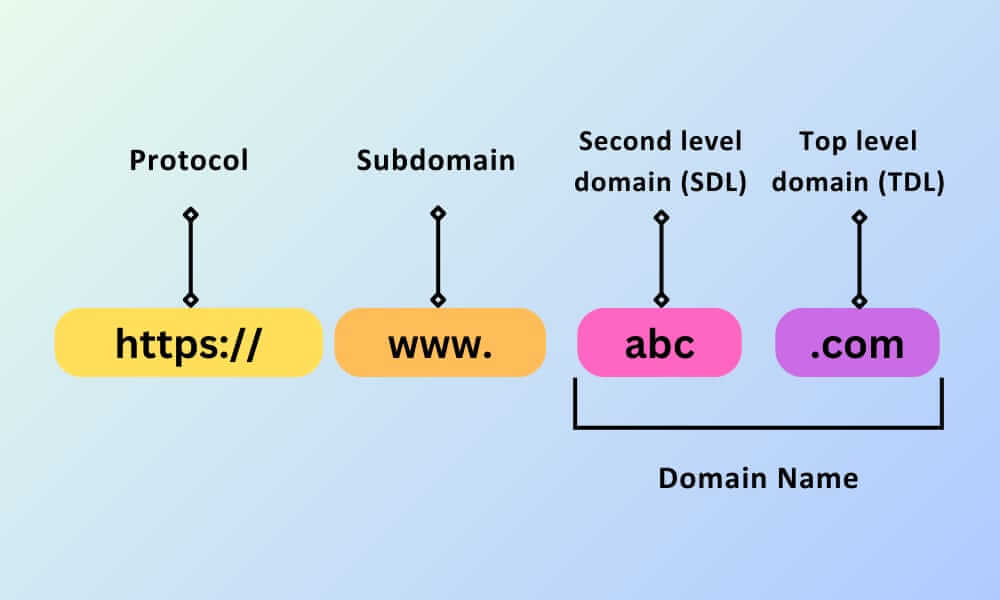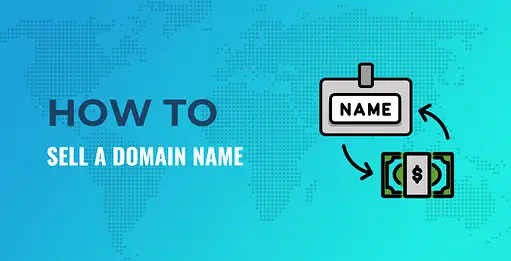Selling Your Domain Name Effectively

Jump To...
A human-readable web address, known as a domain name, serves as the identification for an internet location. It is a user-friendly way to navigate online searches and constitutes the main segment of the URL, consisting of two parts.
Second-Level Domain (SLD)
The initial segment of a domain name plays a pivotal role in serving as the primary identifier for a website, conveying information about the company, industry, or niche it represents. Its critical importance stems from its role as the key element that significantly contributes to the overall value of the domain name.
Top-Level Domain (TLD)
In this section of a domain name, one often encounters terms such as .com, .org, .net, .us, or .uk, which are commonly known as top-level domains (TLDs).

Upon entering a domain name into a web browser, the Domain Name System (DNS) plays a crucial role by translating the human-readable domain name into the corresponding IP address associated with the website server.
Now that we’ve covered the concept of a domain name broker, let’s explore the process of acquiring and selling domain names in the article below:
Domain Name Registration
Organizations authorized by the Internet Corporation for Assigned Names and Numbers (ICANN) or national entities overseeing domain name assignments handle the registration of domain names. Costs are associated with the registration process, participation in auctions, and annual renewals.
Individuals commonly opt for ICANN-recognized domain registrar organizations or their national authorities when seeking to register a domain name. This involves fees for registration, renewal, and potential participation in domain name auctions.
When registering, individuals essentially lease a domain name for a modest annual fee, often just a few dollars. Additionally, an annual fee is required to maintain ownership. The domain name system (DNS) plays a vital role in converting these names into IP addresses, facilitating the identification of computers online.
To register a domain name, individuals typically choose a domain registrar, with well-known options including NameCheap, Simple URL, and GoDaddy.
Domain Name Parking
Essentially, when we register a domain, we are acquiring the right to use it for a specified duration, enabling the creation of email accounts, websites, and more.
However, when we choose to park a domain, we are not utilizing it for these purposes. Instead, parking a domain involves the intention to display advertisements or a temporary landing page.
When seeking to generate income from an unused domain, parking becomes a common practice. This can be achieved through the landing page of unused domains on the same domain parking service where the domain was registered. This allows the domain manager and visitors to see a parked landing page, indicating that the domain is reserved.
Without building a website or setting up email accounts, visitors won’t have access to any content on the domain if it is merely registered.
Now, let’s delve into the process of selling a domain name.
Domain Name Sale
To acquire the knowledge of selling a domain name, individuals should adhere to the following points, as each one holds value in the domain-selling process.
Domain Name Ownership
Prior to engaging in the sale of domain names, one must first assume ownership as a domain manager. Acquiring a domain name can serve various purposes, such as selling it for profit, trading it for another domain, utilizing it for personal purposes, or establishing a business around it. Retaining ownership of a domain can prove beneficial, especially if a business opts to integrate it into their brand due to similarities with their business name or other strategic reasons. This demand has given rise to a business ecosystem where individuals can buy or sell domain names.

Considerations to Bear in Mind
In this comprehensive guide, we will delve into the intricacies of domain selling, addressing various aspects such as assessing the market value of a domain before listing it on auction sites, establishing a reasonable price, preparing the domain for sale, implementing effective marketing strategies, completing successful transactions, leveraging domain markets, taking legal considerations into account, utilizing domain appraisal tools, and exploring additional relevant topics.
Domain Name Marketplace
Promoting your domain on auction sites can significantly enhance its visibility. The value of a domain is influenced by factors such as its length, relevance, popularity, keywords, and extension, as it represents an online identity. Successfully selling a domain involves establishing a fair price, effectively marketing it on auction platforms, engaging with potential buyers, and ensuring a secure and seamless transaction process.

Let’s walk through the procedure of a domain listing and selling a domain name.
Verify the Domain Name's Quality
For a domain name to be considered of superior quality, it should possess the following attributes:
Memorable: A memorable domain name must be simple and catchy, akin to examples like yahoo.com , youtube.com, and facebook.com.
Descriptive: The domain name should convey the content or purpose of the website.
Distinctive: A domain name must be distinct and should not infringe on any trademarks.
Optimizing SEO:
Ensuring that your domain name is search engine friendly is crucial for online visibility.
Incorporate relevant keywords:Integrating keywords into your domain name remains beneficial for SEO rankings. However, it’s essential to avoid excessive keyword usage, aiming for a balanced approach.
Conciseness matters: Opt for a brief and memorable domain name. A succinct and easily remembered name not only contributes to brand recognition but also influences SEO, as exemplified by well-known platforms such as YouTube, Facebook, and Yahoo, all boasting concise names that enhance brand establishment.
Is devoid of symbols and numbers: Avoiding the inclusion of symbols and numbers in a domain name is advisable, as it can impede searchability.
Employs a common top-level domain: The most widely used domain name extensions include .com, .org, and .net, with the “.com” extension present on 37% of all domains. Despite the popularity of “.net” and “.org,” having a “.com” extension is often more advantageous for website performance, given its recognition and ease of recall. It’s advisable to avoid unconventional extensions like “.cars,” “.space,” “.sports,” etc.
Easy to Pronounce and spell: A domain name should be easy to pronounce and spell.
Select a brandable domain name: Brandable domain names distinguish themselves from the competition by possessing a unique identity, unlike generic names laden with keywords that are often forgettable. To enhance the chances of users recommending a quality domain name to their network, simplicity in pronunciation is key.

Evaluate the Value of the Domain
The steps to assess the value of a domain are outlined as follows:
Evaluate Domain Characteristics:
Before selling a domain name, the initial step is to evaluate its value. The worth of a domain name is influenced by several factors:
– Length of the domain.
– Relevance to specific industries.
– Presence of popular keywords.
Consider Domain Extension:
The extension (e.g., .com, .org, .us) plays a significant role in determining a domain’s value. Generally, .com domains are perceived as more valuable, but specific extensions may be suitable for niche markets. The choice depends on the target audience when selling a domain name.
For instance, the .org extension can imply community involvement and a focus on education, often associated with non-profit organizations. Its compatibility with institutions dedicated to innovation and technology breakthroughs in collaborative and instructional settings might be appreciated.
Use Appraisal Tools: Several web tools can be utilized to determine a domain’s value. It’s crucial to note that these tools provide estimates, and the actual market worth depends on the factors mentioned earlier. Here are some appraisal tools:
GoDaddy Domain Value & Appraisal Tool: This tool assesses the potential value of a domain name, considering factors like popularity, length, and keywords. It’s a free tool that generates a comprehensive report, which can be downloaded and printed.
Valuate: This free domain valuation tool calculates an estimated value based on the site’s analytics and sales of related domains. It furnishes a comprehensive summary of information for any entered domain name.
Domain Appraisal Tool: This tool provides a comprehensive analysis of a domain name’s value, considering various factors like backlinks, traffic, and domain age. It generates a detailed report and is available for free use.
Research Comparable Sales: Analyze recent sales of similar domains to grasp market trends and establish a practical selling price. Comparable sales offer valuable insights into the current market conditions, aiding in pricing decisions and determining the optimal presentation strategy for our domain name sale.
Determine Unique Selling Points: Identify any unique qualities or features of the domain that could attract a broader audience. This may involve factors like a history of traffic, brand recognition, or prominent keywords. For instance, a domain such as “TravelGuides.com” holds appeal for buyers in the travel industry, indicating an existing audience interested in travel-related content, making the “travel” keyword a distinctive quality of the domain name.

Prepare the Domain for Selling
Preparing a domain for sale can be done efficiently by following a structured approach.

SEO Optimization: Enhancing SEO boosts a domain’s search result ranking, involving the incorporation of pertinent keywords like industry-specific terms or location-based phrases, as seen in examples such as bestfitnessguides.com or turkeyrestaurants.com.
Content Enhancement: Developing a polished website that emphasizes a domain’s benefits and applications elevates its potential for sale. Superior, niche-relevant content establishes authority, enhancing the domain’s overall appeal.
Transparency: Ensure legal compliance before selling a domain by conducting copyright and trademark searches through WIPO or USPTO databases. Accurate ownership records instill credibility, fostering trust and creating a transparent selling environment.
Preserving Domain Value: Maintain the domain’s value by ensuring it remains registered. Expired domains negatively impact potential buyers due to credibility and accessibility losses. Regular checks and proactive measures, like monitoring registrar settings and setting up notifications, prevent lapses, keeping the domain marketable and operational.
Market Research: Conduct essential market research when preparing a domain for sale. Analyzing niche-specific trends aids in identifying potential buyers or industries interested in the domain. This insight allows sellers to tailor their approach, effectively emphasizing the domain’s relevance and unique value propositions to specific target audiences. A comprehensive understanding of the market landscape enhances the domain’s appeal and value to prospective buyers within its niche.
The subsequent step involves determining a price for your domain by meticulously evaluating various factors contributing to its value.
Determine a Reasonable Cost
These considerations provide valuable insights into establishing an appropriate price when selling a domain name:
Market Alignment: Ensure that the price aligns with current domain marketplaces, balancing competitiveness with profit goals. Regularly research and adjust pricing based on buyer interest to reflect the domain’s value without deterring potential buyers.
Professional Valuation: Consider utilizing domain marketplaces that offer expert appraisal services, particularly beneficial for high-value domains. Expert evaluations provide an informed opinion on the domain’s worth, enhancing the credibility of your pricing strategy.
Forecast Industry Trends: Anticipate future demand by analyzing evolving industry trends, especially those related to keywords or niches associated with the domain. This forward-thinking approach influences pricing strategies to align with potential market shifts.
Varied Approaches: Explore different pricing strategies, including fixed rates, auction-style listings, and negotiation-friendly options. Select a strategy that aligns with the perceived value of the domain and adapts well to market dynamics. Testing various pricing models allows for the most effective response from potential buyers with flexibility.
After establishing the initial domain listing and starting price, let’s explore methods to promote your premium domain names.
Negotiate
Upon identifying a potential buyer for your domain, respond to their inquiries promptly and professionally. Engage in open and transparent discussions about the domain’s features, potential, and pricing. The goal during negotiations is to reach a mutually beneficial agreement, combining flexibility with assertiveness. The practice of purchasing premium domain names and reselling them for profit is referred to as domain flipping, and it has evolved into a lucrative industry.
Managed Windows VPS: Expert Assistance and Seamless Administration
Managed Windows VPS hosting is a comprehensive solution that offers extensive support and maintenance for your virtual private server.
With managed Windows VPS hosting, your hosting provider takes care of all intricate technical tasks related to server management, including setup, security, updates, backups, and performance optimization. This level of support allows you to focus on your core business activities or website content without the burden of server-related concerns.
Ideal for those lacking technical expertise or time for server administration tasks, managed Windows VPS web hosting plans prioritize high levels of security, reliability, and performance for your online presence.
The peace of mind that comes with knowing your hosting provider actively manages and safeguards your server can be invaluable.

Complete the Domain Name Sale
To sell domain names, list yours on domain marketplace such as Sedo, Flippa, or GoDaddy Auctions. We can participate in forums, social media groups, and industry-specific platforms related to the niche to attract potential buyers looking for similar domains.
You can also consider paid advertising or sponsored posts to reach a larger audience.
Contact any domain name marketplace, premium domain name brokers themselves, potential premium domain brokers, domain name buyers, businesses, or domain name brokers that may benefit from the professional domain broker directly.
Also, create personalized messages highlighting your domain’s value and how it relates to their industry or business goals. Networking with people or businesses in related fields may lead to the discovery of potential buyers interested in purchasing the domain.
After selling domains, you are going to lock the deal and use third-party services to protect the deal in case of any inconvenience.
Finalize the Agreement
Upon completing negotiations, it is essential to outline the terms of sale in detail, covering aspects such as the price, accepted payment methods, and the domain transfer procedure. Clear communication in detailing these terms builds trust, fostering a more efficient negotiation process and potentially leading to a higher sale price.

Escrow Service
The funds are held in escrow, with the escrow provider acting as a neutral third party until the successful completion of the domain name transfer. The procedural steps involve:
Buyers and sellers engage in transactions utilizing escrow services. The buyer submits payment to the escrow company through methods like credit cards, wire transfers, or other approved payment options. Once the escrow provider confirms the receipt of the necessary funds, it notifies the seller to proceed with the domain name transfer.
Leveraging Escrow Services for Domain Name Security
Once terms are agreed upon, facilitate a secure payment process. Consider utilizing an escrow provider when dealing with domain names to ensure seamless transactions and safeguard against fraud. In the final stages of negotiations with the new owner:
– The buyer and seller should establish an escrow agreement.
– The buyer uses a credit card, wire transfer, or another payment method to remit funds to the escrow company.
– The escrow service notifies the seller to initiate the domain name transfer after confirming the receipt of funds.
– The buyer confirms the receipt of the domain name, and the escrow service releases funds to the seller after deducting any applicable fees.
Engaging in an escrow service provides both parties with security and peace of mind.
A well-known and reputable escrow service for domain name transactions is escrow.com.
Transfer ownership
The transfer of ownership, facilitated by a domain broker, plays a pivotal role in the process of selling domain names within the domain market.

Secure Domain Transfer
For a secure ownership transfer process in domain selling, rely on reputable services like Escrow.com or Sedo. These trustworthy intermediaries ensure a safe transaction by holding funds until both parties fulfill their obligations. As impartial third parties, escrow services provide assurance and protection against fraud and mismanagement, contributing to a secure and reliable transfer of ownership.
Security
Ensure that the domain transfer adheres to the registrar’s policies. Once you have obtained an authorization number, promptly approve the transfer request. Verify that the agreed-upon funds have been successfully transferred to the buyer’s account. Maintain ownership rights to prevent unauthorized or premature transfers.

With the secure transfer of the domain’s ownership completed, the final stage of the comprehensive process focuses on completing the necessary legalities, ensuring a seamless and conclusive transaction.
Finalize the Legal Procedures
Draft a comprehensive domain sales agreement, delineating the terms and conditions of the domain sale, especially in complex transactions or for added security. Seek guidance from a legal professional to ensure the agreement is thorough and legally binding, safeguarding the interests of both the potential buyer and seller. Upon the completion of the transfer and mutual satisfaction of both parties, formally acknowledge the closure of the transaction. Document the completion of the transaction for future reference and record-keeping purposes.
Quiz section
Which approach to marketing can increase the attractiveness of a domain to potential buyers?
Creating a basic landing page
Engaging in targeted advertising
Avoiding direct outreach
None of above
Which marketing strategy can enhance the appeal of a domain’s auction site for potential buyers?
Future demand and flexibility
Relying solely on market trends
Avoiding diverse pricing strategies
None of above
Conclusion
In conclusion, successfully selling a domain name requires a strategic and comprehensive approach, involving aspects such as valuation, legal compliance, optimization, marketing efforts, negotiation, secure transfer, and addressing legalities. Sellers can enhance their chances of a lucrative sale by diligently assessing the domain’s value, ensuring legal compliance, optimizing its appeal, implementing effective marketing strategies, engaging in professional negotiations, securely transferring ownership, and addressing legal aspects as needed. Clear communication, transparency, and the use of reliable platforms or services are critical components throughout the process. Selling a domain can be a rewarding endeavor when approached with careful planning and adherence to best practices, delivering value to both buyers and sellers in the digital marketplace.



